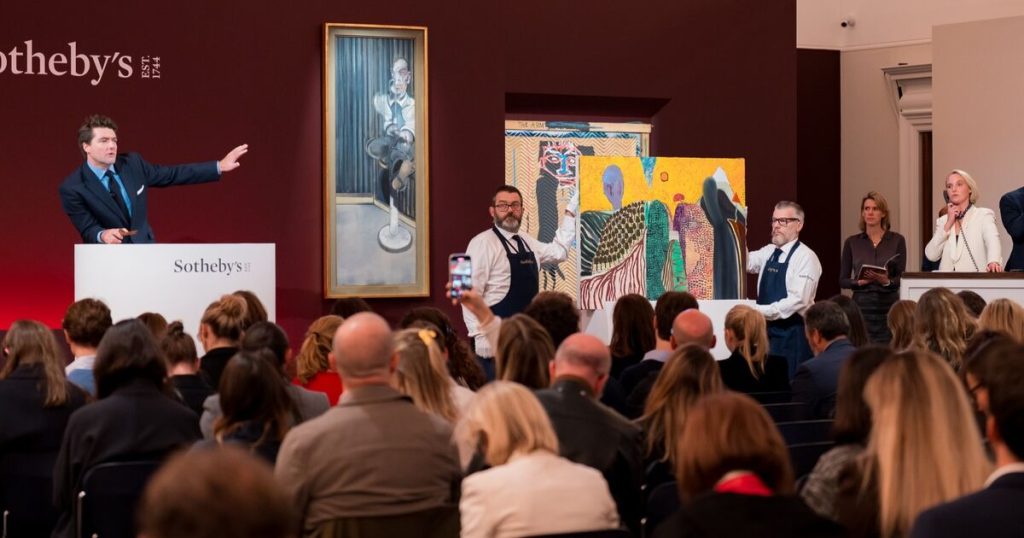Art Market
Photo by Rayan Bamhayan. Courtesy of Sotheby’s.
At an art auction, the number announced when the auctioneer strikes their gavel is rarely the final price for either the seller (also known as the consignor) or buyer in question.
Behind the “hammer price” lies a suite of additional fees that can swing the real cost of a sale, which can differ from one auction house to another, or from location to location.
This guide decodes what both buyers and consignors need to know: how the buyer’s premium works, what sellers need to know about where VAT, sales tax, and Artist’s Resale Right enter the picture, and how to calculate your true “all-in.”
David Hockney, installation view of “The Arrival of Spring in Woldgate in East Yorkshire in 2011.” Courtesy of Sotheby’s.
The main auction fees art buyers need to know
Buyer’s premium
The buyer’s premium is the percentage added to the hammer price of an auction lot; it’s paid by the winning bidder.
Auction houses have different tiering structures that depend on the value of work sold. “For works selling for prices up to and including $1 million, the buyer’s premium rate is 27 percent, 22 percent for works selling for prices in excess of $1 million and up to $8 million,” explained Aleksandra Ziemiszewska, head of contemporary day sales at Sotheby’s London.
Other auction houses have introduced new variations on the model. For example, Phillips introduced a “priority bid” option: Collectors who place bids more than 48 hours before a sale qualify for a discounted buyer’s premium—25 percent instead of 29 percent
Photo by Rayan Bamhayan. Courtesy of Sotheby’s.
Additional buyer charges
Beyond the premium, buyers should note a handful of additional costs.
Local sales tax or VAT is charged to the buyer on the hammer price and buyer’s premium. Where a sale takes place—and where the work is shipped—determines which taxes apply. For instance, a U.S. sales tax is charged based on delivery or pickup location and can add several percentage points to the total, whereas U.K. and European Union buyers typically pay VAT on the buyer’s premium and, in some cases, on the artwork itself if it was imported from outside the region.
“There are different VAT obligations in each country, and whilst we cannot advise on import taxes, we can clarify what the VAT implications are for a work depending on where it is coming from—VAT symbols are published online for every object, but their meaning might be new to first-time bidders,” Ziemiszewska said.
Lots in the U.K. or Europe can also be subject to Artist’s Resale Right (ARR), a small royalty paid to the artist or their estate (if the artist has died in the past 70 years). The fee applies to lots with a hammer price above €1,000 ($1,150) and is collected by the auction house on the buyer’s behalf.
Auctioneer Aurélie Vandevoorde fielding bids during Surrealist and Modern art sales in October 2025. © Thomas Ledoux. Courtesy of Sotheby’s.
Other fees charged to buyers also include:
- Shipping and insurance: costs for packing, delivery, and insurance once the buyer takes ownership.
- Storage fees: if the buyer delays collecting the work after the sale.
- Import/export duties: when moving artworks across borders.
- Credit card or financing fees: in cases where buyers use payment plans or third-party financing to purchase a work.
Where to find the numbers
Details about specific fees are publicly available. Auction houses publish fee structures in their “Conditions of Sale” and note key charges on each lot page, using small symbols to indicate ARR, VAT, or additional taxes. Advisor David Shapiro urges buyers to study those charts: “They’ll tell you if you ask—it’s not a secret.”
The auction fees consignors need to know
Photo by Rayan Bamhayan. Courtesy of Sotheby’s.
Seller’s commission
A seller’s commission is a fee charged to the seller by the auction house for its services. A seller’s commission is usually charged at a rate between 5 and 10 percent.
Seller’s commissions vary from lot to lot depending on an array of factors: the value and desirability of the work, the competitiveness of the consignment, the seller’s relationship with the auction house, and the financial structure of the sale (like guarantees or marketing costs). High-value or prestigious lots often receive lower or waived fees to attract them, while lower-value or riskier works carry higher commissions to cover costs.
“They’re more likely to enforce a seller’s commission on a low-value work,” said Shapiro. “For a high-value piece, they’ll do what they can to get it, since they’re probably competing against other houses.”
Some categories—like design, wine, and online-only sales—carry their own rates. Even within the same auction house, London and New York may apply slightly different terms.
Photo by Rayan Bamhayan. Courtesy of Sotheby’s.
Additional consignor charges
There are several charges that consignors at auction can incur beyond seller’s commission. These include:
- Illustration and cataloging fees: charges for photography, research, and inclusion in printed or online catalogues produced by the auction house.
- Insurance fees: coverage for the work while in the auction house’s custody (often around one to two percent of the reserve price).
- Shipping and handling costs: transport, packing, and storage of the artwork before and after the sale.
- Restoration or conservation fees: if cleaning, framing, or minor restoration is required to prepare the work for sale.
- Marketing or promotional fees: sometimes charged for extra advertising or special inclusion in marketing materials.
- Withdrawal fees: if the consignor removes a lot before the sale after signing a contract.
- Loss on guarantee arrangements: in sales that carry a guarantee, the seller might share a portion of the proceeds above the guarantee or pay a fee if the lot doesn’t sell.
What to know about reserves
Some auction consignments carry a reserve, the confidential minimum price the seller will accept for their artwork.
While auction houses don’t usually charge a separate fee for setting a reserve, a reserve can affect the financial terms of the consignment, such as commission rates, guarantees, and risk-sharing.
Reserves are built into the agreement between the consignor and the auctioneer. However, because the reserve protects the consignor (by ensuring the work won’t sell below a certain level), it can change the auction house’s risk profile and therefore the commission structure or other terms. If the lot fails to meet its reserve, the auction house may charge a percentage of the reserve price in what is called a “buy-in” fee.
MR
Maxwell Rabb
Maxwell Rabb (Max) is a writer. Before joining Artsy in October 2023, he obtained an MFA from the School of the Art Institute of Chicago and a BA from the University of Georgia. Outside of Artsy, his bylines include the Washington Post, i-D, and the Chicago Reader. He lives in New York City, by way of Atlanta, New Orleans, and Chicago.

